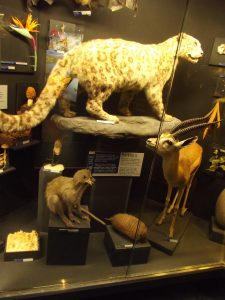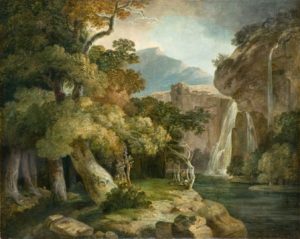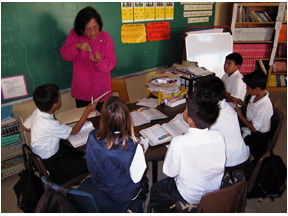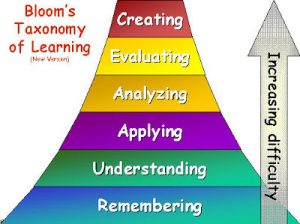1 Cultural ecology
In the late 1980s the head of the zoology department in the National Museum of Wales at Cardiff, Peter Morgan, decided that the old way of presenting animals to people visiting the zoology gallery should change and that visitors should interact with exhibits through the new medium of touch-screen computers (Fig 1).
Fig 1 Exhibiting mammals in the age of taxidermy:National Museum Cardiff
This idea coincided with the development of the concept of ‘natural economy’ by Prof Denis Bellamy in Cardiff University, as a cross-curricular learning framework for world development education. The work was funded by the educational directorate of the European Commission and was launched internationally as a cross-curricular GCSE subject by the University of Cambridge Local Examinations Syndicate. Natural Economy deals with the technical organisation of resources for human well being. It complements Political Economy which deals with the political organisation of people for human well being. This novel conjunction established the Natural Economy Research Unit (NERU) in the museum’s zoology department to explore the use of computers as tools for engaging learners in reflective, critical thinking about the ideas they are studying. In particular, it addressed the question, How can learners analyze and organize what they know, or what they are learning, to make their own personal body of knowledge?. One of the best known semantic organization tools is concept mapping.
Concept mapping requires an ideational framework and natural economy serves this purpose. As a subset of the much bigger concept of cultural ecology it deals with the social relationships between people and the management of their natural resources. To be effective the framework must accommodate people, going beyond the narrow circle of “authorized personnel” to follow their own cognitive process of building a personal body of knowledge.
A highlight of these pioneering days was the networking of natural economy across Europe as a Welsh contribution to the Schools Olympus Satellite Programme, which was uploaded from Gwynedd County Council ‘s North Wales terminal at Llangefni.
Cultural ecology is best approached through landscapes which have been moulded by humans wresting a living from local rocks, soils and ecosystems. Learning about the limits of this effort to boost human wellbeing begins with a specific landscape and its various elements as a heritage menu. A landscape’s component biological and physical elements are cross-curricular historical markers of past cultures. These are the artefacts presented to learners of all ages in museums. In fact every element on a museum’s public gallery is the tip of an information iceberg in the ‘sea’ of cultural ecology and the starting point of concept mapping as a quest for knowledge.
NERU was funded by the EU to explore the use of computer assisted learning as part of the process of mind mapping gallery artefacts upon which visitors could build their own story. The phrase electronic gallery guides (EGGs) was coined to describe the connections, available with touch screen computers, that placed an artifact in an augmented reality. This form of cross curricular mindmapping offers great opportunities for establishing individual learning routes, which are best described as personal quests, each starting with a cultural element. As the world-wide web developed, NERU worked with Welsh and English schools and their communities to produce a series of mind maps, called bioscopes, as quests outlining routes from the past and present to living sustainably in the future. These were created with the Apple Macintosh Hypercard system and MindJet’s MindManager. These learning routes are called epistemic games. Their focus is on helping learners to think like professionals, such as engineers or journalists. Epistemic games are anchored in an apprenticeship learning model in which students are confronted with a real-world issues that require creative solutions. The purpose is not necessarily to steer them towards a certain profession but rather to have them learn to think innovatively and understand the complexities of solving meaningful problems in the modern world. Although these games are not designed to train students for specific professions, they do provide an opportunity to explore a potential job. This is a valuable approach to enriching transition planning for students with disabilities and students in schools where actual internships are impractical or unavailable.
Although the visitor experience in museums is often the result of passing through subject barriers at high speed to make the most of a day out, this passage offers opportunities to increase levels of scientific understanding in the context of a particular object’s wider cultural significance. For example, the Cardiff art galleries are rich in 18th century landscape paintings and EGGs were produced linking ‘ecological exhibits’ in the arts and zoology galleries through the topic of conservation management, where environmental aesthetics and mindfulness in the presence of Nature made the bridge (Fig 2)
Fig 2 River at Penegoes c 1750, National Museum Cardiff: depiction of ancient oak woodland
This connection to a neighborhood through a mindful approach is one of the pillars of a community ecomuseum. In the 1980s the idea of ecomuseums emerged as a local focus on landscape elements that define the identity of a place. An ecomuseum is assembled with volunteer participation, and has the objective of enhancing the welfare and development of local communities. These community museums originated in France, the concept being promoted by Georges Henri Rivière and Hugues de Varine, who coined the term ‘ecomusée’ in 1971. The term “éco” is a shortened form for “écologie”, but it refers especially to a new idea of holistic interpretation of cultural heritage as a landscape quest. It may be contrasted with the focus on specific items and objects defined by expert curators of traditional museums. An ecomuseum, coupled with epistemic games is a community ‘big history’ for generating a local pride of place and action plans for environmental improvements..
Examples of digital ecomuseums produced by NERU in partnership with local communities are;
Denbigh Area
https://www.sites.google.com/site/denbigharea/Home
Blything
http://blything.wikispaces.com/
Nine Parishes
http://nineparishes.wikispaces.com/
Lowestoft
http://lowestoft.wikispaces.com/
Halesworth
http://halesworth.wikispaces.com/
Lincoln
http://www.biodiversity.ecoworld.co.uk/lincolncms/
Community Landscapes: North Wales
http://www.communitywalk.com/communities_in_landscapes_north_wales/map/1459746#121:01010653.NI^7-3.2eh510
2 WebQuests
Fig 3 WebQuest:’Teeth’
Nowadays the ideas behind the NERU EGG have been developed as the on line WebQuest (Fig 3). The first WebQuest used simply paper and pencil, when San Diego State University’s Bernie Dodge was working on a lesson for second-semester student teachers concerning an educational software package. But Dodge didn’t have access to the software, so instead he accumulated as much information on paper as he could about the product: evaluations, printouts of Web sites devoted to the topic, and even a transcript of a Web chat with one of the developers. He organized this material into thematic sections, and then handed them over to the students. Their job was to internalize the information, then collaboratively develop a working plan for determining whether or not the software was viable for the school where they were teaching (Fig 4).
Fig 4 A paper WebQuest in the classroom
Dodge told Education World magazine that he knew from the beginning that he had stumbled onto something special: “It was great! Having done my part ahead of time by organizing the resources, I had to speak very little during the two hours they worked on it. I enjoyed walking around and helping where necessary and listening to the buzz of conversations as students pooled their notes and tried to come to a decision. The things they were talking about were much deeper and more multifaceted than I had ever heard from them. That evening I realized that this was a different way to teach —and that I loved it!”
In 1995, Dodge and Tom March developed a type of lesson plan, which they termed a “WebQuest’ that incorporated links to, from, and along the newly born World Wide Web. Students were presented with a scenario and a task, usually a problem to solve or a project to complete. The students were given Internet resources and asked to analyze and synthesize the information and come up with their own creative solutions. Over the next three years, teachers wrote their own WebQuests, and instructors began to teach WebQuests in their workshops and classes. Fortunately, this proliferation of curricular materials convinced many teachers that it was all right to publish their own WebQuests on line for others. Most teachers have included their e-mail addresses, which allow a WebQuest user to contact the teacher and discuss quest results. Additionally, WebQuest sites have sprung up and continue to grow on the Internet.
Dodge defines a WebQuest as an activity that pulls together the most effective instructional practices into one integrated learner activity. These Web-based projects use World Wide Web sites to help students develop problem-solving and decision-making skills, on their own or collaborative groups..
An effective WebQuest develops critical thinking skills and often includes a cooperative learning component. Students learn as they search for information using the Web, following a prescribed format that focuses on problem solving and authentic assessment. A well-written WebQuest requires students to go beyond simple fact finding. It asks them to analyze a variety of resources and use their creativity and critical-thinking skills to solve a problem. WebQuests help students analyze, synthesize, and evaluate information. The ultimate learning experience is for a student to produce a WebQuest to teach other students what they have learned.
http://techieenglishteacher.blogspot.co.uk/2014/03/webquests-best-way-to-foster-critical.html
A Cardiff EGG and a Dodge WebQuest are both classified as epistemic learning games; an inquiry-oriented lesson format, in which most or all the information that learners work with comes from the Web. These can be created using various programmes, including a simple word processing document that includes links to websites. The following programmes are examples of software tools for making WebQuests.
http://www.xerte.org.uk/index.php?lang=en
http://teacherweb.com/
http://questgarden.com/
http://zunal.com/
https://www.spiderscribe.net
The following quests were made with the Zunal and Spiderscribe software systems.
Rescue Mission Planet Earth
http://zunal.com/conclusion.php?w=311554
Equal Rights
http://zunal.com/webquest.php?w=314824
Envisage the Future
http://zunal.com/webquest.php?w=314651
The Porcelain Project
https://www.spiderscribe.net/app/?acd8f6dd4961658157ca60f758c11838
3 Resource-guided learning pathways
A WebQuest is distinguished by two outstanding characteristics of inquiry-led education.
First, it emphasizes higher-order thinking (such as analysis, creativity, or criticism) rather than just acquiring information. Second, the author preselects the resources, emphasizing smart information use rather than information gathering. Thereby a webquest goes beyond data and information accumulation and the resources are used as a guide toward the generation of useful and applicable knowledge, a process supported by inquiry learning.
Questing is more relevant today than ever. In the past, the UK’s success depended on the education of narrow subject specialists to tap the country’s natural resources. Today, it depends upon a generalist workforce that “works smarter.”
Through the process of resource-guided learning individuals construct much of their understanding of the natural and human-designed worlds. Inquiry implies a “need or want to know” premise. Inquiry is not so much seeking the right answer, because often there is none, but rather seeking appropriate resolutions to questions and issues. For educators, inquiry implies emphasis on the development of inquiry skills and the nurturing of inquiring attitudes or habits of mind that will enable individuals to continue the quest for knowledge throughout life.
At the centre of a WebQuest is Bloom’s cognitive system with the educational outcomes structured in a hierarchical order (Fig 5 ).
Fig 5 The cognative system according to Bloom
A lesson objective based upon the story of Goldilocks and the Three Bears is presented for each of the six levels of BLOOM’s Cognitive Process. Remember: Describe where Goldilocks lived. Understand: Summarize what the Goldilocks story was about. Apply: Construct a theory as to why Goldilocks went into the house. Analyze: Differentiate between how Goldilocks reacted and how you would react in each story event. Evaluate: Assess whether or not you think this really happened to Goldilocks. Create: Compose a song, skit, poem, or rap to convey the Goldilocks story in a new form.
At the lowest level students are required to know, memorize, repeat and list information. At the higher levels students are required to judge, criticize, resolve, invent, and make recommendations. Each of the levels builds in complexity from the previous level. Carefully selected verbs are used to involve students in thinking differently at each level. A WebQuest is therefore a resource guided learning pathway.
A WebQuest is different from a “scavenger hunt,” a much simpler approach that is as old as the Web itself. In a typical scavenger hunt, students are given a list of items they must find answers to questions, for example, or instances of data and are set loose on the Web. WebQuests are much more structured and focus heavily on an ideational framework with links to websites researched by a teacher.
Fig 6 A Zunal WebQuest about making conservation management plans
http://zunal.com/webquest.php?w=332484
It is recommended that every WebQuest has six basic components (Fig 6).
(i) Introduction.
This is an overview of what is to come; it describes the rationale of the course, its vocabulary and learning context.
(ii) Task
This section details the course objectives in the form of packages of resources that must be accessed in sequence to complete the Quest.
(iii) Process.
It is here that students use the resources in each package to develop a personal compilation of ideas and information, often working in groups, to meet the objectives. This may involve role-playing and other off-line methods.
Learning resources are texts, videos, software, concepts and definitions that teachers have selected to assist students to meet the expectations for learning. Links to resources are added to each page of the on-line presentation..
The Process section spells out step by step what learners will do, how they will interact with, each other, and with information. The teacher may want to have everyone reading one set of pages, and then break them into groups with separate roles, each with a different set of links to look at.
After the students have examined the information they need to transform it in some way. Here is where they play with ideas, make decisions, and so on.
Finally, learners actually produce something that reflects the thinking they did. They may be writing a position paper, preparing a debate, creating a model or applying their learning to solve a practical problem. The teacher might want to provide some writing prompts or other forms of guidance to help them act more skilled than they presently are.
Every step should be clearly stated. Activities should be clearly related and designed from basic knowledge to higher level thinking. Different roles are assigned to help students understand different perspectives and/or share responsibility in accomplishing the task
(iv) Evaluation.
The evaluation of a student’s progress centres on a “rubric,” a carefully designed chart listing goals for the quest and the standards by which performance will be measured. This can be thought of as a great widening of the typical letter grade usually given to classroom assignments. Rubrics are highly annotated “grades” with extensive annotation detailing many aspects of the project. There can be an evaluation of the Quest by students which is similarly structured.
(v) Conclusions
This is a brief summary, usually congratulatory in tone, that wraps up the project.
(vi) Teacher Page.
Instructors are provided with their own subsection of the WebQuest site, with instructions for each of the above sections. Teachers who develop WebQuests often fill this section with information to help other educators adapt the quest to their own class.
6 Why bother?
Ultimately, the WebQuest idea is about more than simply using the Web for research. It is a structured process for introducing concepts, problems, building methodical approaches to solving those problems, and then getting students to tackle them.
From this perspective using WebQuests can help build a solid foundation that prepares students for an adult world.
Why should a teacher take the time to create a WebQuest? The best reason is that, like any carefully planned lesson, a good WebQuest makes learning interesting for students. Beyond that, however, several other factors make WebQuests powerful learning tools. First, a good WebQuest puts the power of the web behind a topic. A teacher can show students – or let them discover for themselves, not just tell them. Web sites can take students anywhere in the world. WebQuests are a way to let students work at their own pace, either individually or in teams. A WebQuest lets students explore selected areas in more depth, but within limits that you have selected. This makes WebQuests ideal for classes which combine students with different ability levels. WebQuests offer a different, more dynamic approach to teaching the value of research. WebQuests can also increase the “comfort level” of students using the Internet for learning activities. While students are probably already computer literate, a properly designed WebQuest can help them become creative researchers rather than simply “surfing” from one site to another.
WebQuests are based on the ideas of inquiry and constructivism. WebQuests also incorporate cooperative and collaborative learning, since students can work on projects in groups. These concepts can play a role in teaching with WebQuests. WebQuests can also help students meet standards focused on critical-thinking and analysis skills. Alternative kinds of assessment can be used to judge the results of WebQuest projects. And, obviously, WebQuests are one way to use the Internet in education. WebQuests are tools, not educational theories, so they can be used in virtually any classroom with appropriate computer access. However, above all a WebQuest releases the teacher and students from the intellectual tyranny of national curricula based on old subject boundaries. It is unfortunate that most schools lack the freedom to use them in mainstream teaching. In addition, a recent survey has revealed teacher-perceived drawbacks of the use of the Internet , viz. students’ cheating, unreliable information, technical problems, and students’ extracurricular activities during lessons.





